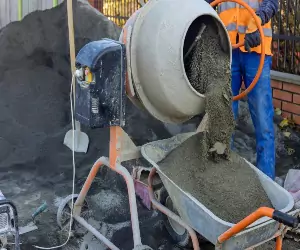
Varieties and Roles of Chemical Admixtures in Construction
What are Chemical Admixtures?
To enhance concrete performance and strength, chemical admixtures are added to concrete during the mixing process. They are introduced in small quantities and can significantly improve the performance and workability of the concrete. These additives are categorized into different types according to their distinct functions and impacts on the composition of a concrete mixture.
Types of Chemical Admixtures:
∙ Water-Reducing Admixtures (Plasticizers):
These admixtures reduce the water needed in the concrete mix while maintaining the desired workability. They improve the mix’s flowability and enhance the concrete’s strength and durability.
∙ Retarding Admixtures:
Retarders slow down the setting time of concrete, allowing for more extended placement and finishing periods. It is convenient in hot weather or large concrete pores where rapid setting might be challenging.
∙ Accelerating Admixtures:
Conversely, accelerators hasten the setting time of concrete. They are beneficial in cold weather or when a quick turnaround is required for construction projects.
∙ Air-Entraining Admixtures:
Air-entraining agents create microscopic air bubbles in the concrete, improving its freeze-thaw resistance. It is crucial in climates where concrete is exposed to freezing and thawing cycles.
∙ Plasticizers (Superplasticizers):
These admixtures improve the workability and flowability of concrete without increasing water content. Superplasticizers are plasticizers that can provide even higher levels of water reduction.
∙ Set-Controlling Admixtures:
These admixtures control the rate of cement hydration and setting, especially when a delay in setting time is required.
∙ Corrosion-Inhibiting Admixtures:
These chemical admixtures help protect reinforcing steel in concrete from corrosion caused by chloride ions or other aggressive substances. They are essential for increasing the durability of concrete structures.
∙ Shrinkage-Reducing Admixtures:
These admixtures mitigate the drying shrinkage of concrete, reducing the likelihood of cracking. It is imperative in large concrete structures where cracking can be a significant concern.
∙ Colouring Admixtures:
Colouring agents can be added to concrete to create a wide range of colours. It is often used for decorative concrete applications.
∙ Waterproofing Admixtures:
These admixtures enhance the impermeability of concrete, making it more resistant to water penetration. It is valuable in structures such as basements and foundations.
Functions of Chemical Admixtures in Construction
∙ Water Reduction (Plasticizing):
Reduce the water needed in the concrete mix without compromising workability. It enhances the strength and durability of the concrete while improving its flowability.
∙ Setting Time Control:
Adjust the setting time of concrete to meet specific construction requirements. Retarding admixtures delays setting time, while accelerating admixtures speed it up.
∙ Strength Enhancement:
Improve the compressive and flexural strength of concrete. Admixtures such as superplasticizers can contribute to higher early and ultimate strength.
∙ Workability and Flowability Improvement:
Enhance the ease of handling, placing, and finishing of concrete. It is crucial for achieving the desired surface finish and overall construction quality.
∙ Air Entrainment:
Introduce microscopic air bubbles into the concrete, improving freeze-thaw resistance. Air-entraining admixtures are critical in cold climates.
∙ Durability Enhancement:
Increase the resistance of concrete to various deteriorating factors, such as chemical attack, abrasion, and corrosion of reinforcing steel. Corrosion inhibitors and waterproofing admixtures contribute to durability.
∙ Shrinkage Reduction:
Minimize the drying shrinkage of concrete, reducing the likelihood of cracking. Shrinkage-reducing admixtures are especially useful in large concrete structures.
∙ Temperature and Weather Considerations:
Adapt concrete properties to temperature conditions. Accelerating admixtures can be used in cold weather while retarding admixtures are beneficial in hot weather.
∙ Colour Modification:
Add pigments or colouring agents to achieve specific aesthetic effects in decorative concrete applications.
∙ Waterproofing:
Enhance the impermeability of concrete, making it more resistant to water penetration. It is critical in structures like basements and foundations.
∙ Set-Controlling Chemical Admixtures:
Controlling the rate of cement hydration and setting, which is vital in specific construction scenarios.
∙ Cost Reduction and Performance Optimization:
Improve the overall performance of concrete while reducing costs associated with materials, construction time, or maintenance.
The concrete’s properties and performance undergo a certain level of optimization with the help of these admixtures during construction. The successful execution of construction projects is initiated by these indispensable tools for achieving strength, durability, workability and overall project grade.
Chemical admixtures are crucial in modern concrete production, as they enhance their properties and performance. While Vinplast-245 manufactured by Vinati Organics may not directly act as a concrete admixture, it provides significant benefits to manufacturers of such admixtures. These additives, which include superplasticizers and air-entraining agents, enhance the workability, strength, durability, and setting time of concrete mixtures.
By integrating Vinplast-245, concrete admixture manufacturers can optimize their formulations, achieving greater water reduction and improved workability without sacrificing quality. This innovation highlights the importance of chemical additives in advancing the construction industry, ensuring the production of high-quality concrete for diverse applications. Vinati Organics is committed to providing top-notch solutions to address the changing demands of the construction sector. Feel free to get in touch with us for further information on Vinplast-245.
FAQs
Chemical admixtures are additives used in concrete to alter its properties. They can improve the workability, durability, strength, and other concrete properties. Common types include plasticizers, which improve workability by reducing water content; accelerators, which speed up the curing process, useful in cold weather conditions; retarders, which slow down the setting time, beneficial in hot climates or large projects; and air-entraining agents, which create tiny air bubbles, improving freeze-thaw resistance. Additionally, superplasticizers can greatly reduce water content while maintaining workability.
The main types of chemical admixtures used in concrete are plasticizers, accelerators, retarders, air-entraining agents, and superplasticizers. Plasticizers improve workability by reducing water content. Accelerators speed up the curing process, useful in cold weather. Retarders slow down setting time, beneficial in hot climates or large projects. Air-entraining agents create tiny air bubbles, enhancing freeze-thaw resistance. Superplasticizers significantly reduce water content while maintaining workability. Each type offers unique benefits, allowing concrete mixes to be tailored to specific project requirements for optimal performance and durability.
Water-reducing admixtures, also known as plasticizers or water reducers, are additives used in concrete to improve workability without increasing water content. By dispersing cement particles more effectively, they enhance the fluidity of the mix, allowing for easier placement and consolidation. This results in concrete that is more cohesive and easier to handle, reducing the need for excessive water, which can weaken the final product. Water-reducing admixtures ultimately enhance the performance and durability of concrete structures while optimizing construction processes.
Accelerating admixtures, often containing calcium chloride or calcium nitrate, speed up the hydration process of cement in concrete. They accomplish this by increasing the rate of chemical reactions between cement particles and water. This acceleration leads to faster setting times and earlier strength development, making them particularly useful in cold weather conditions or when rapid construction schedules are required. Accelerating admixtures help ensure timely project completion without compromising concrete quality or performance.
Air-entraining admixtures introduce tiny air bubbles into concrete during mixing. These bubbles act as a buffer, reducing damage caused by freezing and thawing cycles. By dispersing throughout the concrete matrix, they improve the material’s ability to withstand the expansion pressures exerted during freezing, thus enhancing its durability in cold climates or environments prone to freeze-thaw cycles. Air-entraining admixtures help prevent cracking and deterioration, ensuring the long-term integrity of concrete structures.
Chemical admixtures can be used in various types of concrete mixes to modify their properties and enhance performance. However, their suitability depends on factors such as the specific application, desired concrete characteristics, and environmental conditions. While most admixtures are compatible with common concrete formulations, it’s essential to consider factors such as dosage, compatibility, and potential interactions with other materials to ensure effective and safe use in different types of concrete.
When used according to manufacturer guidelines, chemical admixtures are generally safe for use in concrete. They undergo rigorous testing to ensure they meet industry standards and regulatory requirements. However, like any construction material, improper handling or misuse can pose risks. It’s crucial to follow recommended dosage rates, application procedures, and safety precautions to minimize potential hazards. Adhering to best practices helps ensure the safe and effective use of chemical admixtures in concrete construction projects.





